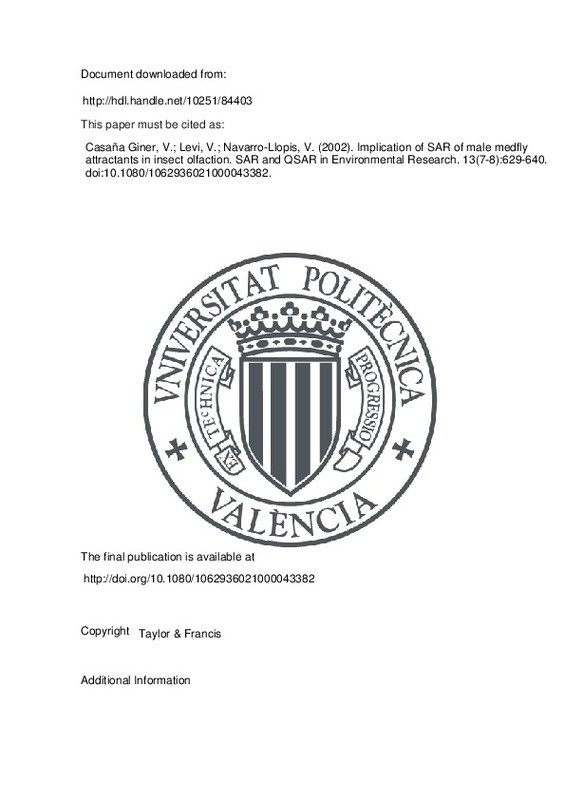JavaScript is disabled for your browser. Some features of this site may not work without it.
Buscar en RiuNet
Listar
Mi cuenta
Estadísticas
Ayuda RiuNet
Admin. UPV
Implication of SAR of male medfly attractants in insect olfaction
Mostrar el registro sencillo del ítem
Ficheros en el ítem
| dc.contributor.author | Casaña Giner, Víctor
|
es_ES |
| dc.contributor.author | Levi, V.
|
es_ES |
| dc.contributor.author | Navarro-Llopis, Vicente
|
es_ES |
| dc.contributor.author | Jang, E.B.
|
|
| dc.date.accessioned | 2017-07-04T09:51:16Z | |
| dc.date.available | 2017-07-04T09:51:16Z | |
| dc.date.issued | 2002-11 | |
| dc.identifier.issn | 1062-936X | |
| dc.identifier.uri | http://hdl.handle.net/10251/84403 | |
| dc.description.abstract | [EN] Medfly (Ceratitis capitata) males are strongly attracted by different compounds, not described as pheromones. The best attractants reported are (+)-alpha-copaene, a sesquiterpene of natural source and (-)-ceralure-B1, a non-natural iodinated cyclohexane ester. Although their origin, atomic composition, chemical and physical properties are rather different, they show similar attraction to medflies. The question of why these compounds, act behaviorally in the same way, has been never addressed in research papers. We show here for the first time that these compounds have quite similar stereochemistry, water accessible surfaces, certain local dipole moments and, to some extent, similar octanol/water partition coefficient (log P). When seven carbons, one oxygen and one iodine belonging to (-)-ceralure-B1 are selectively chosen based on topological homology with (+)-alpha-copaene and are overlaid with nine corresponding carbons of (+)-alpha-copaene, the RMS is 0.367 Angstrom. This represents a high degree of steric resemblance. Local dipole moments and charges are similar in those regions where the molecules show topological homologies. Thus, we hypothesize that these two molecules could interact with the same male medfly's odorant receptor(s). The implications of this result in future research in insect olfaction is discussed. | es_ES |
| dc.language | Inglés | es_ES |
| dc.publisher | Taylor & Francis | es_ES |
| dc.relation.ispartof | SAR and QSAR in Environmental Research | es_ES |
| dc.rights | Reserva de todos los derechos | es_ES |
| dc.subject | Ceratitis capitata | es_ES |
| dc.subject | Medfly | es_ES |
| dc.subject | Insect olfaction | es_ES |
| dc.subject | SAR | es_ES |
| dc.subject | Copaene | es_ES |
| dc.subject | Ceralure | es_ES |
| dc.title | Implication of SAR of male medfly attractants in insect olfaction | es_ES |
| dc.type | Artículo | es_ES |
| dc.identifier.doi | 10.1080/1062936021000043382 | |
| dc.rights.accessRights | Abierto | es_ES |
| dc.contributor.affiliation | Universitat Politècnica de València. Centro de Ecología Química Agrícola - Centre d'Ecologia Química Agrícola | es_ES |
| dc.description.bibliographicCitation | Casaña Giner, V.; Levi, V.; Navarro-Llopis, V.; Jang, E. (2002). Implication of SAR of male medfly attractants in insect olfaction. SAR and QSAR in Environmental Research. 13(7-8):629-640. doi:10.1080/1062936021000043382 | es_ES |
| dc.description.accrualMethod | S | es_ES |
| dc.relation.publisherversion | http://doi.org/10.1080/1062936021000043382 | es_ES |
| dc.description.upvformatpinicio | 629 | es_ES |
| dc.description.upvformatpfin | 640 | es_ES |
| dc.type.version | info:eu-repo/semantics/publishedVersion | es_ES |
| dc.description.volume | 13 | es_ES |
| dc.description.issue | 7-8 | es_ES |
| dc.relation.senia | 27651 | es_ES |
| dc.identifier.pmid | 12570041 |








